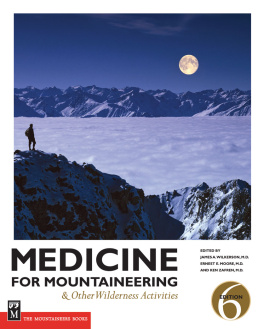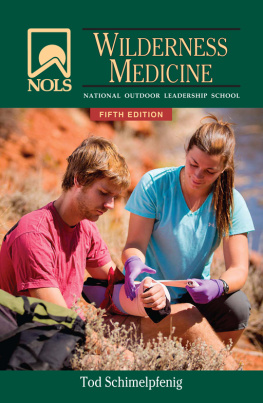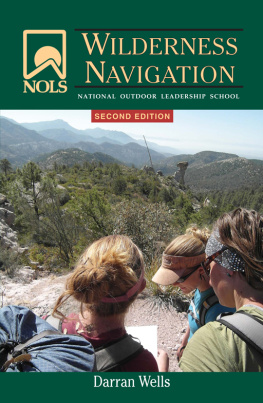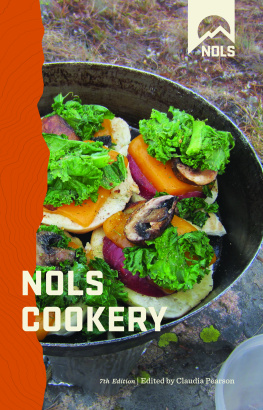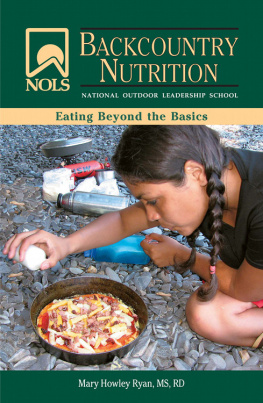TOD SCHIMELPFENIG
As a wilderness educator and a volunteer EMT on ambulance and search and rescue squads for the past forty-four years, Tod Schimelpfenig has extensive experience with wilderness medicine and risk management. He began his NOLS Field Instructor career in 1973, leading numerous courses and course types, culminating in the first father-son instructor team at NOLS. He served as the NOLS Risk Management Director for eight years, the NOLS Rocky Mountain School Director for six years, and for three years on the board of directors of the Wilderness Medical Society (WMS). He has received the Reb Gregg Award for contributions to the field of Wilderness Risk Management, twice received the WMS Warren Bowman Award for contributions to the field of wilderness medicine, and was elected a Fellow of the Academy of Wilderness Medicine. Tod is the founder of the Wilderness Risk Managers Committee, has spoken at numerous conferences on pre-hospital and wilderness medicine, and has taught wilderness medicine around the world. He has written numerous articles on educational program, risk management, and wilderness medicine topics, and he currently reviews articles for the Journal of Wilderness and Environmental Medicine. Tod recently retired after serving for 18 years as the Curriculum Director of NOLS Wilderness Medicine.
This book and its six previous editions owe much to the assistance of:
Linda Lindsey, Human Resources Director for NOLS, who coauthored the first three editions of this text.
Shana Tarter, Gates Richards, and Ben Lester of NOLS Wilderness Medicine for their editorial suggestions.
Jo Rolls PA-C for her work on the chapter on genitourinary medicine.
Herb Ogden, M.D., NOLS Medical Advisor, for his advice and support of NOLS instructors and students.
Laura McGladrey PMHNP for her work on stress injury management.
Cynthia B. Stevens, M.D. for her assistance to NOLS on matters of mental health and work on the mental health chapter.
Charles Reb Gregg for his assistance with the medical legal chapter.
NOLS Wilderness Medicine Instructors Javier Cea, Felipe Jcome, and Gabriel Puma for their review and help with the translation of this text.
And the generations of NOLS field and wilderness medicine instructors whose suggestions and experience are vital in helping this text be as relevant and practical as possible.
These are the contents of a standard first aid kit designed for a group of twelve on a monthlong trip. (This is the inventory of a NOLS Field Instructors Kit.) Requirements will vary with group size, medical qualifications, trip length, location, and remoteness.
| General Supplies | No. |
|
| Biohazard bag | 1ea |
| Nitrile gloves | 1 pair |
| Latex gloves | 4 pairs |
| Micro shield | 1ea |
| Thermometer (digital) | 1ea |
| Signal mirror | 1ea |
| Whistle | 1ea |
| Foot Repair | No. |
|
| Scissors | 1ea |
| Ace bandage | 1ea |
| 1 Athletic tape | 1ea |
| Moleskin (2 3) | 2ea |
| Molefoam (2 3) | 2ea |
| Adhesive knit (2 3) | 2ea |
| Second Skin (2 3) | 2ea |
| K-tape (2 3) | 2ea |
| Wound Care | No. |
|
| 2 2 gauze pad | 4ea |
| 3 4 nonstick gauze pads | 2ea |
| Opsite Transparent dressing | 2ea |
| 4 4 gauze pad | 2ea |
| Band-Aids | 12ea |
| Steri-strips | 6ea |
| 3 gauze roll | 1ea |
| Tweezers | 1ea |
| Cravats | 1ea |
| Oval eye pads | 2ea |
| Safety pins | 2ea |
| 12cc syringe | 1ea |
| Bactracin 11/32 oz | 2ea |
| Cortisone 11/32 oz | 2ea |
| Benzoin 1 oz | 2ea |
| Betadine 1 oz | 1ea |
Anaphylaxis. A hypersensitive reaction of the body to a foreign protein or drug.
Anorexia. A lack of appetite.
Appendicular. Refers to the limbs, the legs and arms.
Ataxia. Incoordination of muscles. Usually seen when voluntary movement is attempted; e.g., walking.
Avulsion. A forcible tearing away of a body part. It can be a piece of skin, a finger, toe, or entire limb.
Axial. Referring to the midline through the skeleton, the skull, verte-brae, and pelvis.
Axillary. Referring to the armpit.
Bacteria. Unicellular organisms lacking chlorophyll.
Basal metabolic rate. The metabolic rate of a person at rest. Usually expressed in kilocalories per square meter of body surface per hour.
Basal metabolism. The amount of energy needed to maintain life when the body is at rest.
Brachial. Refers to the arm, usually the brachial artery or nerve.
Brain stem. The portion of the brain located below the cerebrum, which controls automatic functions such as breathing and body temperature.
Campylobacter. A genus of bacteria implicated in diarrheal illness.
Capillary. The smallest of the blood vessels; the site of oxygen, nutrient, and waste product exchange between the blood and the cells.
Cerebellum. The portion of brain behind and below the cerebrum, which controls balance, muscle tone, and coordination of skilled movements.
Cerebrum. The largest and upper region of the brain. Responsible for higher mental functions such as reasoning, memory, and cognition.
Comminuted. A fracture in which several small cracks radiate from the point of impact.
Congenital. A condition present at birth.
Conjunctiva. The mucous membrane that lines the eyelid and the front of the eyeball.
Convection. Heat transferred by currents in liquids or gases.
Cornea. The clear transparent covering of the eye.
Crepitus. A grating sound produced by bone ends rubbing together.
CRT. Capillary refill time. For example, Capillary refill time is 3 seconds.
Cyanosis. Bluish discoloration of the skin, mucous membranes, and nail beds indicating inadequate oxygen levels in the blood.
Diabetes. A disease resulting from inadequate production or utilization of insulin.
Distal. Farther from the heart.
Electrolyte. A substance that, in solution, conducts electricity: Common electrolytes in our body are sodium, potassium, chloride, calcium, phosphorus, and magnesium.
Embolism. An undissolved mass in a blood vessel; may be solid, liquid, or gas.
Epilepsy. Recurrent attacks of disturbed brain function; classic signs are altered level of consciousness, loss of consciousness, and/or seizures.
Eversion. A turning outward (as with an ankle). Giardia. A genus of protozoan, a simple unicellular organism that causes an illness that is often characterized by diarrhea.
Globule. Any small rounded body.
Hematoma. A pool of blood confined to an organ or tissue.
Hyperglycemia. High blood sugar.
Hypoglycemia. Low blood sugar.
Intercostal. The area between the ribs.
Irrigate. To flush with a liquid.
Kilocalorie. A unit of heat; the amount of heat needed to change the temperature of 1 gram of water 1 degree centigrade.


